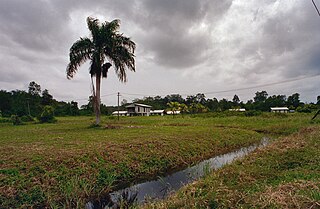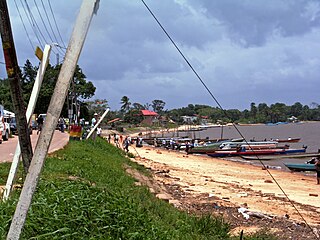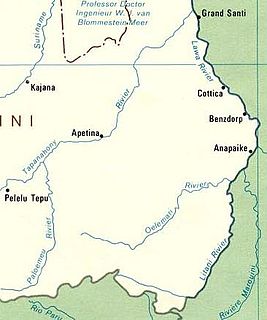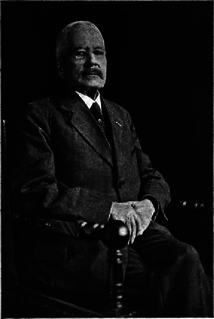
Commewijne is a district of Suriname, located on the right bank of the Suriname River. Commewijne's capital city is Nieuw Amsterdam. Tamanredjo is another major town, while Meerzorg is the most populated.

The Aluku are a Bushinengue ethnic group living mainly on the riverbank in Maripasoula in southwest French Guiana. The group are sometimes called Boni, referring to the 18th-century leader, Bokilifu Boni.

The Paramaccan or Paramaka are a Maroon tribe living in the forested interior of Suriname, mainly in the Pamacca resort, and the western border area of French Guiana. The Paramaccan signed a peace treaty in 1872 granting the tribe autonomy.
The Kwinti are a Maroon people, descendants of runaway African slaves, living in the forested interior of Suriname on the bank of the Coppename River, and the eponymous term for their language, which has fewer than 300 speakers. Their language is an English-based creole with Dutch, Portuguese and other influences. It is similar to the languages spoken by the Aluku and Paramaccan Maroons, and split from Sranan Tongo in the middle 18th century. The Kwinti had a population of about 300 in 2014 and adhere to the Moravian Church.

Nieuw Nickerie is the third largest city in Suriname with a population estimated at 12,818. It is the capital city of the Nickerie district, and the terminus of the East-West Link.

Albina is a town in eastern Suriname, and is capital of the Marowijne District. The town lies on the west bank of the Marowijne river, which forms the border with French Guiana, directly opposite the French Guianan town of Saint-Laurent-du-Maroni, to which it is connected by a frequent ferry service. Albina can be reached by bus via the East-West Link. The distance between Paramaribo and Albina is about 150 kilometres (95 mi).

Wanhatti is a village and resort in Suriname, located in the Marowijne district on the Cottica River. The resort is inhabited by the Ndyuka Maroons, and has a population of 468 people as of 2012. The village is primarily inhabited by Ndyuka of the Ansu clan or lo.

Nieuw Amsterdam is the capital of the Commewijne District in Suriname. It is a small coastal town situated at the confluence of the Suriname River and Commewijne River, just across from Paramaribo, the country's capital. Its population at the 2012 census was 5,650, with around 1,200 people living in the main town, most of whom are of Javanese and East Indian origin. It is the location of the historical Fort Nieuw-Amsterdam, today an open-air museum. The town of Mariënburg with former sugarcane factory is located 3 km from Nieuw Amsterdam and part of the resort.

Tapanahoni is a resort in Suriname, located in the Sipaliwini District. Its population at the 2012 census was 13,808. Tapanahoni is a part of Sipaliwini which has no capital, but is directly governed from Paramaribo. Tapanahony is an enormous resort which encompasses a quarter of the country of Suriname. The most important town is Diitabiki which is the residence of the granman of the Ndyuka people since 1950, and the location of the oracle.

Kwakoegron is a town and resort in Suriname. It is located inland, due south of Paramaribo. According to the 2012 census it has a population of 263, and is mainly inhabited by Maroons, of the Matawai people. The resort and town are named after Kwakoe, the native word for Wednesday, and grond, the Dutch word for ground. The captain of the resort resides in the village Commisariskondre.

The Litani or Itany is a river which forms part of the boundary between Suriname and French Guiana. It is a tributary, or the upper course, of the Maroni. The boundary is disputed, with Suriname also claiming land to the east of the river.

Nieuw Jacobkondre is a town in the Sipaliwini District of Suriname. It is situated on the Saramacca River. The village is inhabited by Matawai people.

Oelemari River is a river of Suriname. The Oelemari River flows into the Litani which is a tributary to the Marowijne. The river is sourced from the Oranjegebergte which in turn is a subdivision of the Tumuk Humak Mountains. Gold has been discovered in the area and is being exploited by Guardian Exploration from Texas.

Kabalebo River is a river in Suriname. It joins with the Courantyne River near Apoera. A plan for a dam in the river serving a hydroelectric power plant is part of the West Suriname Plan of the 1960s. As of 2020, no construction has taken place. Petrogylphs had been discovered on a rock by Ten Kate in 1886.

The Coeroeni River is a river in South America. It arises in the Tumuc-Humac Mountains, which forms the drainage divide between Pará, Brazil, and Suriname; from there it flows northward. The river is fed by the Aramatau, Kutari and Sipaliwini River. The Coeroeni goes on to form the border of the disputed Tigri Area by Guyana and Suriname. It eventually flows into the Courantyne River, which forms the international boundary between Guyana–Suriname.

Alkmaar is a resort in Suriname, located in the Commewijne District. Its population at the 2012 census was 5,561.

The Ndyuka people or Aukan people (Okanisi), are one of six Maroon peoples in the Republic of Suriname and one of the Maroon peoples in French Guiana. The Aukan or Ndyuka speak the Ndyuka language. They are subdivided into the Opu, who live upstream of the Tapanahony River in the Tapanahony resort of southeastern Suriname, and the Bilo, who live downstream of that river in Marowijne District
The Sikiana are an indigenous people, living in Brazil, Suriname, and Venezuela.

Granman is the title of the paramount chief of a Maroon nation in Suriname and French Guiana. The Ndyuka, Saramaka, Matawai, Aluku, Paramaka and Kwinti nations all have a granman. The paramount chiefs of Amerindian peoples in Suriname are nowadays also often called granman.

Herman Daniël Benjamins, was a Surinamese educator, editor and writer. He is best known as the founding editor of De West-Indische Gids, and editor of the Encyclopaedie van Nederlandsch West-Indië (1914-1917).

















